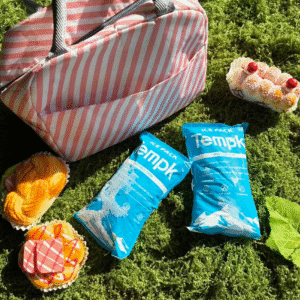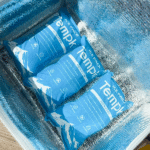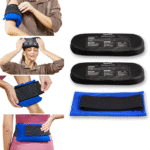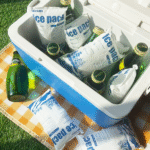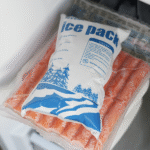Dry ice packs can swell or burst during transport if CO₂ gas is trapped—pressure changes alone are not the cause. Your goal is simple: let the gas out while keeping the cold in. With vented liners, planned headspace, and compliant labeling, you prevent swelling, protect handlers, and keep payloads within spec across road and air routes.
-
Why do dry ice packs swell or burst?
-
Do altitude and pressure changes matter?
-
How much headspace is “enough”?
-
What design stops swelling?
-
What should your SOP say in 2025?
Why do dry ice packs swell or burst during transport?
Dry ice packs swell or burst when CO₂ gas is trapped inside a sealed liner or airtight box. Sublimat es kering (Solid → Gas) as it warms, and that gas expands hundreds of times in volume. If it cannot escape, the film balloons and seams fail.
Think of a shaken soda bottle — the fizz wants out; the cap decides whether it swells or sprays. A micro-perforated or valve bag “cracks the cap” so CO₂ bleeds out safely. Add modest headspace so pellets don’t choke the vent. This approach works in hot last-mile vans and at cruising altitude alike.
How much gas do dry ice packs actually make?
| Dry Ice Mass | Approx. CO₂ Volume (L) | Approx. CO₂ Volume (m³) | Apa artinya bagimu |
|---|---|---|---|
| 0.25 kg | ~130 L | 0.13 m³ | Needs visible vent path in small coolers |
| 0.5 kg | ~260 L | 0.26 m³ | Leave slack in the liner |
| 1.0 kg | ~520 L | 0.52 m³ | Headspace + micro-vents prevent ballooning |
| 2.5 kg | ~1,300 L | 1.30 m³ | Split into multiple vented bags |
| 5.0 kg | ~2,600 L | 2.60 m³ | Use engineered vents and strong insulation |
Do “pressure changes” in airplanes or mountains burst dry ice packs?
Not if dry ice packs are vented. Pressurized cargo holds and cabins reduce ambient pressure but do not cause failures by themselves. What matters is venting and headspace.
Air cargo compartments target cabin altitudes around 6,000–8,000 ft. Road lanes see temperature swings and elevation changes. In both, the same principle applies — vented dry ice packs, visible vent paths, modest headspace, and no sealed seams at the lid.
Headspace: how much do dry ice packs need?
Aim for 15–25% internal headspace. That protects vents, absorbs early-hour gas, and avoids lid pressure on the film.
| Jenis Pengiriman | Headspace Target | Mengapa itu berhasil | Untukmu |
|---|---|---|---|
| Pharma/biotech air | 20–25% | Accounts for altitude and tarmac heat | Lower swelling + ventilasi yang sesuai |
| Frozen food ground | 15–20% | Balances cold life and gas release | Fewer bulging boxes |
| Long-haul air | 18–25% | Extra buffer for spikes | Smooth airline acceptance |
What pack design keeps dry ice packs from bursting?
Choose a vented liner, keep the vent path open, and separate the pack from the payload. Never heat-seal around dry ice. Maintain a “lid zone” so CO₂ rises and exits.
Step-by-step packout
-
Pra-dingin the shipper; load the payload first.
-
Menimbang es kering; split into multiple vented dry ice packs.
-
Menutup dengan a fold-and-clamp or valve/perf liner — no heat seals.
-
Shim untuk 15–25% headspace; keep vents exposed.
-
Label with UN 1845 dan berat; do not block vent paths.
What should your 2025 SOP include?
-
Vented liner required.
-
Headspace maintained at 15–25%.
-
First-hour gas check in PQ logs.
-
Label: Dan 1845 + Berat bersih.
-
Pelatihan: staff recognize swelling early.
Are you mixing up dry ice packs and gel packs?
Paket gel don’t create gas. Paket es kering are solid CO₂ and must vent. If both are used, place gel near product and dry ice above, with a pad separating vents.
2025 trends in pressure-safe dry ice packs
Smart vent membranes, CO₂ dots, and hybrid refrigerant designs now dominate cold chain packaging. These improve safety, kepatuhan, and sustainability while cutting rework.
Kemajuan terbaru sekilas
-
Clamp-closure vented bags: consistent venting geometry
-
Headspace shims: maintain clearance automatically
-
Sensor CO₂: low-cost indicators for training and QA
FAQ
Do dry ice packs swell or burst during transport due to pressure changes?
Only if CO₂ is trapped. With vented liners and headspace, routine pressure changes don’t cause bursts.
How much headspace should I leave above dry ice packs?
Keep 15–25% internal volume free for venting and expansion.
What reduces swelling fastest?
Switch to valve or perforated liners, expose the vent, and split large bags into smaller vented ones.
Do I need special rules for airplanes?
Same as ground: vented liners, ruang kepala, and proper labels.
Ringkasan & Rekomendasi
Dry ice packs burst only when CO₂ is trapped. Use vented liners, 15–25% headspace, and exposed valve paths. Add a first-hour gas check, and split large loads into multiple vented packs.
Langkah selanjutnya:
-
Run a CO₂ volume check.
-
Replace heat-sealed bags with vented ones.
-
Add shims for headspace.
-
Validate with trial shipments.
Tentang tempk
Tempk provides pressure-safe cold chain solutions balancing temperature, keamanan, and acceptance speed. Our vented dry ice packs and hybrid PCM designs reduce swelling and extend cold life.
Ready to ship safer? Contact our team for tailored recommendations.






